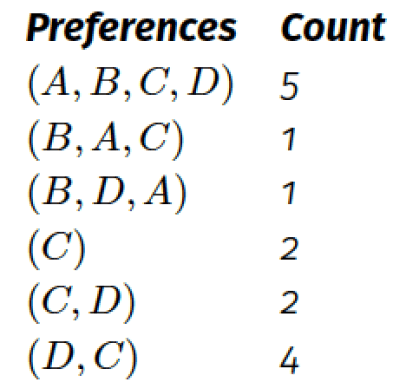Table of Content
- Getting Started
- Introduction: IRV RAs with RAIRE
- IRV elections and Visualizing Outcomes
- Assertions for IRV winners
- Risk Limiting Audits
- Using assertions to audit IRV outcomes
- Margin and Difficulty
IRV elections and Visualizing Outcomes
Instant Runoff Voting (IRV) is a preferential voting system where voters rank candidates in order of preference. If no candidate receives a majority of first-preference votes, the candidate with the fewest votes is eliminated, and their votes are redistributed to the remaining candidates based on the next preferences. This process repeats until a candidate receives a majority, ensuring that the winner reflects the preferences of a broader range of voters.
How IRV Counts Work
In Instant Runoff Voting (IRV) elections, voters rank candidates in order of preference. Initially, each candidate receives the votes where they are ranked first. The candidate with the least votes is eliminated, and their votes are transferred to the next preferred candidate on each ballot. This elimination process continues until one candidate has a majority and is declared the winner.
Example
Suppose there are 4 candidates: Alice, Bob, Chuan, and Diego. The votes are as follows:

We first count the first preference tallies: Alice has 5 votes, Bob has 2, Chuan has 4, and Diego has 4. This means that Bob is eliminated first and his votes are distributed to the next-preferred candidate on each ballot—Diego gets the (B, D, A) vote and Alice gets the (B, A, C) vote. The new tallies are Alice: 6, Bob: eliminated, Chuan: 4, Diego: 5. Now Chuan is eliminated. Diego gains two more votes—the (C, D) ballots—and wins with 7 votes compared to Alice’s 6.
